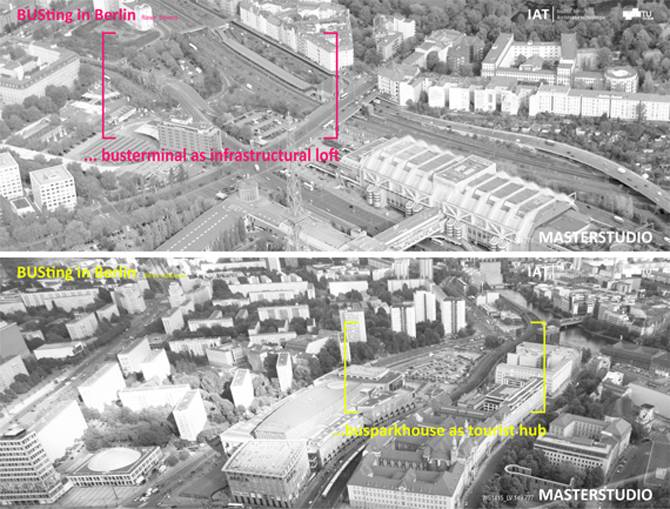Institute of Architecture Technology TU Graz
3 - 7 November 2014
BUSting Berlin – hybrid infrastructures
Berlin is a dynamic, vital metropolis with both a complex rich history and a generous openness for creative appropriation and new, innovative developments. Thus the city counts as one of the favourite destinations in Europe. The studio adresses the topic of mobility arising from that precondition and the question of how Berlin is actually being accessed. Within this frame we focus especially on the current phenomenon of increasing bus travel.

The city is currently re-thinking types of traffic infrastructures using, their potential dynamics to become hybrid urban interfaces for the city. Two scenarios are being researched by design:
Bus Terminal as Infrastructural Loft
Due to the statutory liberalisation of intercity bus traffic in Germany in 2013, the ZOB [Central Bus Station] Berlin cannot handle the large number of buses and passengers that have tripled in the last 1.5 years. The “worn out“ ZOB, built in 1966, urgently needs a redesign to manage the roughly 3 million passengers and 165,000 buses per year, the numbers continue to grow. We will take this opportunity and relocate it, transforming a complex plot just next to the Berliner Ring A100 and the Tradefair Berlin into a new infrastructural hub comparable to the qualities the traveler experiences at airports. Not a roofed stop to hop on but rather a terminal to board: a bus terminal. Being neighbour to the tradefair offers further potentials concerning urban programs. We ask for enhanced potentials of infrastructural buildings, designing structures for mixed-use that are yet undetermined, offering systems for adaption and public spatial resources that go beyond the monofunctional infrastructure of a bus terminal to make it a hybrid public framework. In reference to Kees Christianse´s “City as loft“ we will regard the bus terminal as an infrastructure with the potential of an urban “loft.“
Bus Park as Tourist Hub
Either by plane, train, private car or bus, Berlin is accessed by an ever-increasing number of tourists. Invaded by tourist buses on a daily basis, Berlin’s attractive center is in urgent need of a new strategy. What about a centralized model, serving a limited but highly touristy area of Berlin? A stacked car-park upgraded to a real tourist hub: the bus traveler’s entrance gate to Berlin right next to Berlin Alexanderplatz on an empty vast plot. This newly developed transport node has to function as a receiver, mediator and distributor of tourist flows. A new hybrid typology: the busparkhotel.
Has infrastructure in a city center ever been an attractive task for architects? The task challenges us to approach the issue of bus mobility in the form of new typologies: the hybrid infrastructures. So, how can they improve performance in the urban environment? Moreover, considering the highly privileged location next to Alexanderplatz and the Tradefair Berlin, can a building dedicated to transport catalyze new urbanity? The assignment consists of designing a structure capable of linking city and mobility. A hybrid where infrastructural use, public space and urban programs come together. It shall become a strong feature of Berlin‘s cityscape and provide an animated, lively experience.
Studio Coordinators: Prof. Roger Riewe, Sorana Radulescu, Marcus Stevens
Part of the ANCB Programme
Smart City. The Next Generation

